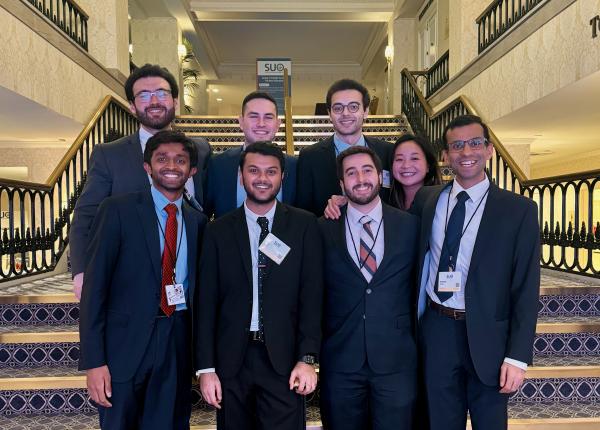Reflections on a ‘Research Year’ in Urology at the NIH
BY JESSICA HSUEH, NCI

CREDIT: JESSICA HSUEH, NCI
A cohort of MRSP and CRTA fellows have completed their medical school research year at the NIH. Pictured are (top row from left to right): Kyle Schuppe, David Gelikman, William Azar, and Jessica Hsueh; (bottom row from second left to right) Sahil Parikh, Jason Hyman, and Nityam Rathi. Standing on the first step is Jay Siva, a summer intern.
Across the country, medical students have found themselves asking the same question: “Should I take a research year?” While such an experience may not be for everyone, I can say that I and my NIH cohort benefited immensely from a yearlong immersion at the NIH.
Coming into medical school, I pondered the possibility of taking a year to explore my passions within medicine. As I juggled classes and rotations with research, I knew that I wanted to dedicate significantly more time to investigating my personal clinical research interests. When I discovered my love for urology and how interwoven innovation and creativity are in this field, I was energized with a desire to take an extra year in medical school to focus on growing as a researcher.
As I embarked on the daunting process of finding a home for my research year, I never imagined it would eventually take me to the NIH, a place I didn’t realize had such a diversity of research opportunities. But it was here where I met dozens of similarly minded medical students, including six I would bond with who, like me, came to pursue a research year at NCI. Five of us entered through the Medical Research Scholars Program (MRSP), a year-long program dedicated to training the next generation of physician-scientists. Two others were conducting their research year through the NCI Urologic Oncology Branch as Cancer Research Training Award (CRTA) fellows.
Although we are all united in our shared passion for research, we also had our own individual reasons for wanting to work at the NIH.
“Coming from a fairly new community-based program, I was impressed that the NIH could provide me the opportunity to directly pursue answers to questions I had from prior research but was unable to engage in at home,” Kyle Schuppe said. Schuppe, an MRSP scholar, has been able to participate in both clinical and bench research, focusing on new therapies and novel metabolic imaging techniques for the treatment and monitoring of castrate-resistant prostate cancer.
Jason Hyman, a CRTA fellow, also wanted to expand his breadth of experiences to help with future research efforts. He participated in multiple projects assessing the relationship between genetic events and clinical courses of von Hippel-Lindau syndrome and exploring the benefits of a novel HIF-2-alpha inhibitor. One of the more compelling aspects about working at the NIH was the opportunity to develop tangible research skills by taking classes at the Foundation for Advanced Education in the Sciences (FAES). In line with his goal to expand his research skills, Hyman learned Python programming language for statistical analysis and chart review.
MRSP scholar William Azar similarly benefited from a combination of NCI and FAES offerings, developing a profound understanding of the impact of technology in health care. “Because I am conducting research on medical-device development and the applications of artificial intelligence (AI) and large language models in medical data extraction and analysis, I chose to enhance my skills by taking courses in Python, R, and statistics programs,” he said.
Our research year has undoubtedly left us with invaluable experiences, shaping our career trajectories as future surgeon-scientists. MRSP scholar Nityam Rathi dedicated his year to studying hereditary renal cancer syndromes after having previously investigated the medical and surgical management of localized and metastatic kidney cancer. David Gelikman, also an MRSP scholar, studied applications of AI to improve diagnosis of prostate cancer using magnetic resonance imaging (MRI). “Working in a radiology lab that focuses on genitourinary imaging, I gained a unique perspective on diagnosis and continued surveillance of multiple urologic malignancies,” Gelikman said.
After exploring the use of 3D quantitative transmission ultrasound tomography and MRI for prostate cancer detection, this research year solidified CRTA fellow Sahil Parikh’s desire to become a physician-scientist and integrate research into his practice. “My year has stressed the importance of interdisciplinary collaboration, with a reinforced desire to combine academic pursuits with clinical practice,” Parikh said. “This year has shown how important it is to have a support system and a mentor that believes in you and that all have a common goal.”
Ultimately, what has made our research year so special is the strong sense of community and camaraderie at the NIH. “My favorite experience has been meeting and collaborating with trainees who share a similar passion for academic urology,” Rathi said. Gelikman echoed a similar sentiment, stating, “I loved attending multiple urology conferences along with the other medical students and getting to work on projects together.”
From sharing lunches and attending happy hours, to board game nights and trips to Washington, D.C., monuments, we have bonded inside and outside of the NIH. As our research year concludes, we are infinitely grateful for the opportunities we have been given at the NIH, and we cannot wait to pursue our urology careers—together, as colleagues and lifelong friends.
David Gelikman, NCI, also contributed to this article.

Read more about the 2023-2024 MRSP class, which included 52 medical students who received world-class training at the NIH, in the “I Am Intramural Blog.”
This page was last updated on Tuesday, December 3, 2024
